Taken literally, the term “sport compact” simply refers to a car that is both sporty in nature and compact in size, but the term as most of us understand it today applies primarily to high-performance variants of compact economy cars. Honda’s Si (and Type-R), Subaru’s STI and Mitsubishi’s Evolution are all classic examples of high-performance, tuner-friendly versions of econoboxes that continue to be at the heart of the sport compact segment. But as we all know, the concept of sport compact is constantly being redefined by the marketplace and, more specifically, by the core group of enthusiasts who live and breathe for these types of vehicles. Just look at this month’s cover car—a V-8 swapped Lexus GS300—and it’s easy to see how the culture of young import enthusiasts has evolved to include a much wider range of vehicles than just those that fall under a traditional definition of sport compact.
 |
The Series 2 Lotus Elise chassis has been widely used for road racing.
|
The Series 2 Lotus Elise chassis has been widely used for road racing.
The USDM Lotus Elise that hit U.S. showrooms in the summer of 2004 as a ’05 model certainly didn’t meet many of the traditional characteristics of a sport compact, given its sticker price, extruded and bonded aluminum chassis and exotically styled fiberglass clamshell body. In truth, the Elise is more of an exotic sports car than a sport compact. But with dozens of ’05 and ’06 Elises on AutoTrader.com for less than $30,000, these very sporty and very compact speed machines are worth a closer look if you’re a weekend warrior who loves to tear it up at the track or around the autocross course.
For those of you who are unfamiliar with the American-market Lotus Elise, it’s based upon an improved version of the Series 1 (’96–01, not sold in the U.S.) all-aluminum chassis. Unlike the Series 1 and its Rover K-series engine, the Series 2 USDM Elise is powered by a 189-bhp version of Toyota’s (co-developed with Yahama) 2ZZ-GE 1.8-liter four-banger, an engine rated at 180 bhp in the ’00–05 Celica GT-S, Matrix XRS, Corolla XRS and Pontiac Vibe GT. Lotus’ remapping of the ECU not only extracted the extra 9 bhp, it also broadened its usable horsepower range by lowering the VVTL-i engagement point by a few hundred rpm.
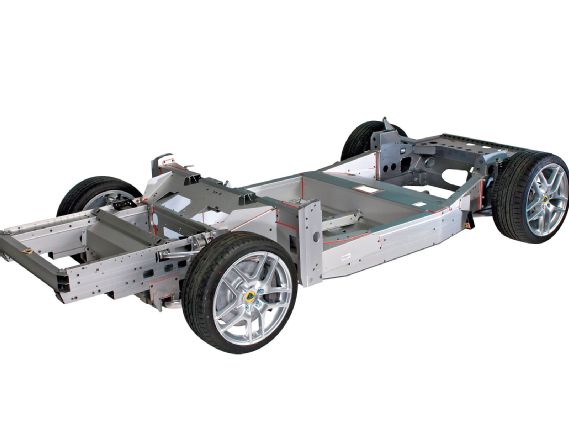 |
The all-aluminum chassis of the Elise is extruded and then bonded, riveted and bolted together to create an incredibly strong and lightweight platform.
|
The all-aluminum chassis of the Elise is extruded and then bonded, riveted and bolted together to create an incredibly strong and lightweight platform.
Having been completely seduced by the Elise driving experience at a recent press event—its incredibly low mass (2,000 lbs), unequaled steering feel and razor-sharp handling that allows it to simultaneously defy the laws of physics and the posted speed limit in a unique and totally engaging way—I turned to Shinoo Mapleton at Sector 111 to learn more about the car’s tuning potential. As the leading Elise and Exige tuner in America, Sector 111 knows plenty about making these lightweight pocket rockets even faster than they already are.
When I asked Shinoo what attracted him to the Elise, his response surely echoes that of most Lotus owners: “I am crazy about simple and light sports cars that lack electronic driving aids. I want to be a part of the driving action and not managed by the latest electronic nanny. The feel is raw compared to the others cars your readers might be interested in. The Elise is really for tracks and twisty backroads. You buy a Lotus for the handling and feel, not for power or 0–60 times. Think performance through light weight.”
Although the Elise is about as uncompromising a road-legal driving machine as money can buy, according to Shinoo there is room for improvement. “Lotus delivers a fantastically balanced sports car for road and track use, but they are constrained by road regulations that result in a few compromises. Significant improvements can be found with the right modifications. A ride-height-adjustable suspension would be ideal on every Lotus but is far too expensive at the OE level. This is where the aftermarket can supply legitimate solutions. Every one of the Lotus Challenge Series (a 2-year-old West Coast–based road racing series) racers are running a car with some level of modification and are going faster as a result. As an example, most of the fastest LCS guys are running Nitron suspension [a high-quality UK brand that makes advanced coilover systems]. So, yes, you can actually make a great-handling Lotus handle even better. The track and, ultimately, racing is a great proving ground.”
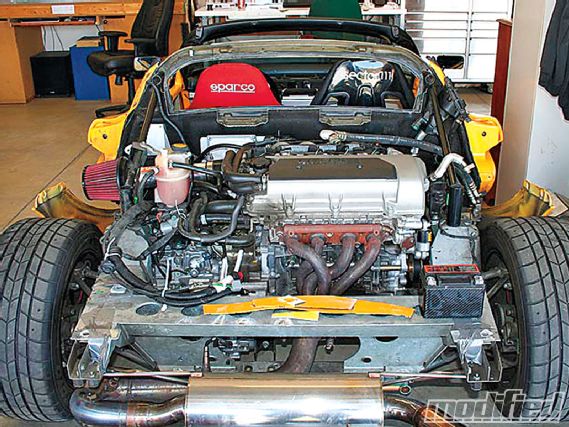 |
With the rear clam removed, access to the engine, drivetrain and exhaust system is a snap.
|
With the rear clam removed, access to the engine, drivetrain and exhaust system is a snap.
With a name like Nitron you might get the impression that Lotus Elises are expensive to modify, and to some extent this is true. But just like with an EVO or STI, it depends entirely on how much faster than stock you want to go. According to Shinoo, “They are more expensive to modify because there are so few of them built, but it’s not cost prohibitive. The first mod I usually recommend is a harness for improved track performance and safety [there is a factory-integrated roll bar in these cars that is triangulated to the rear, so it’s safe to use a 5- or 6-point racing harness]. Beyond that, there are three issues that should be addressed in any frequently tracked Lotus: the rear toe link weakness, oil starvation and fuel starvation. Solutions for these three problems areas exist and will ensure reliability and safety. Make sure you have a good alignment, too, as these cars are very sensitive. After that, the sky is the limit, but I would recommend getting a couple of track days under your belt before going wild. I recommend removing weight as it helps all performance categories. Brakes, suspension and lastly power would be the order of mods I would take.”
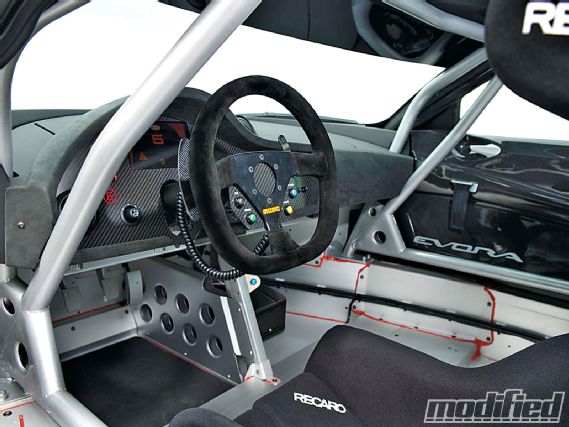 |
Since you can’t weld steel to aluminum, rollcages must be bolted to a Lotus chassis.
|
Since you can’t weld steel to aluminum, rollcages must be bolted to a Lotus chassis.
The Elise has excellent aerodynamic balance from the factory, thanks in part to its low nose, slick shape, flat bottom and aluminum rear diffuser. But significant improvements to total downforce and front/rear balance are possible if you equip one with functional parts like those made by ReVerie. According to Shinoo, “ReVerie is one of our key suppliers. Their parts have made many of our clients turn much faster and more confident lap times. The Lotus benefits from properly designed aero and luckily ReVerie has sorted some great solutions.” All of ReVerie’s parts—including front spoilers and splitters, undertrays, rear diffusers, rear wings and side skirts—feature aerospace quality carbon-fiber construction and have been wind tunnel tested. Just what you would expect from a company that has designed and built aerodynamic parts for Formula 1, and unlike most aero companies, they’ve made some of their wind tunnel test results available online (http://www.reverie.ltd.uk/techdata.php).
One of the negatives I’ve heard about Elises is that the aluminum chassis is quite fragile—an off-track excursion has the potential to cause expensive damage that’s difficult (or even impossible) to repair. Here’s what Shinoo had to say on the subject: “The chassis is a 150-lb asset of the car that can take a good track beating and actually provides some good safety protection. Any severe hit to a suspension mount can be disastrous, but there are specialists who are sorting out good fixes. New clams can be expensive, but repaired clams are becoming very affordable. A Lotus is not a cheap car to fix compared to a sport compact vehicle, but compared to a Porsche or Ferrari it’s a relative bargain.”
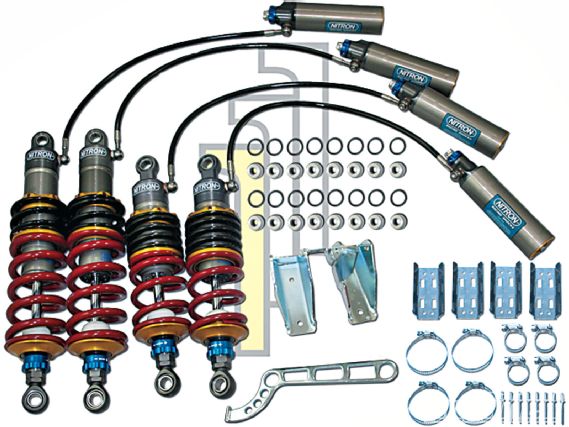 |
Sector 111 recommends a coilover suspension setup as one of the first modifications for an Elise. These high-quality Nitron coilovers are the company’s preferred choice.
|
Sector 111 recommends a coilover suspension setup as one of the first modifications for an Elise. These high-quality Nitron coilovers are the company’s preferred choice.
The other most common criticism aimed at the Elise is its tight interior, but according to Shinoo, “I have seen some guys as big as 6 feet, 5 inches and 230 lbs fit into these cars. Anyone at these extremes must be limber and athletic to make it work. Even for shorter folk, you generally must be willing to fold yourself up a bit to get in or out. Once you are in, the driving position is pretty good for most. We have seat-lowering kits that buy some additional headroom. A rollcage will definitely restrict ingress/egress and the overhead bars can come in contact with your helmet if you’re taller than 6 feet and/or have an especially long torso. It would be best to sit in a Lotus with your helmet on before deciding if this car is a good fit for you. Of course, if you drive it on track, you will likely get hooked and make whatever mods you can to fit.”
Having worked on a friend’s SW20 Toyota MR2, it left me with very little desire to ever turn another wrench on a mid-engine car. There was just no room to work on that motor. Accessing the engine in a Series 2 Elise or Exige can also be a challenge, according to Shinoo, but the rear clam can be removed in about an hour, giving you full access to the engine, drivetrain and rear suspension and exhaust system. You’ll need a second person to remove the clam, though, given its size.
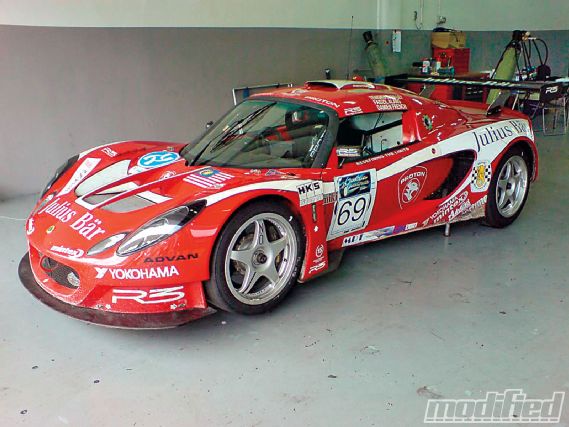 |
A Super GT version built by Proton.
|
A Super GT version built by Proton.
Although there are some challenges associated with owning and modifying a S2 Lotus Elise, the upside makes it an intriguing replacement option for my now-complete G35 project car. If I decide to do some Elise shopping, Shinoo recommends examining the chassis for any signs of crash damage or repair to the suspension mounts because this area is the hardest to fix on the aluminum chassis. He also recommends getting a PPI done by a Lotus dealer, including an ECU download to look for any signs of over-revving or repeated abuse. For me the biggest concern remains helmet clearance since I’m tall in the torso, but with a seat-lowering kit from Sector 111 I may just fit.

